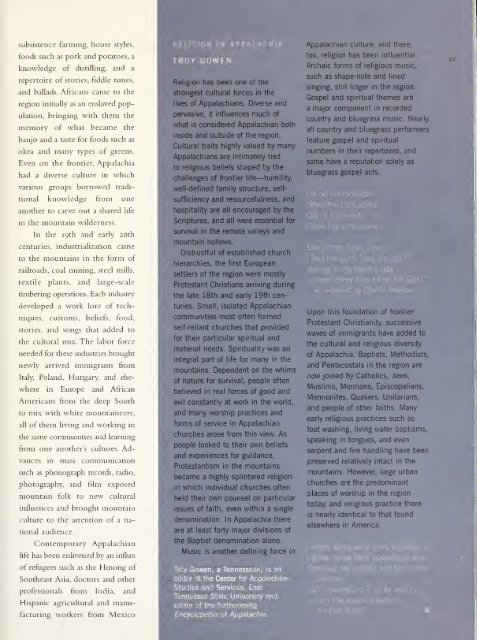SCOTLAND - Smithsonian Digital Repository - Smithsonian Institution
SCOTLAND - Smithsonian Digital Repository - Smithsonian Institution
SCOTLAND - Smithsonian Digital Repository - Smithsonian Institution
Create successful ePaper yourself
Turn your PDF publications into a flip-book with our unique Google optimized e-Paper software.
subsistence farming, house styles,<br />
foods such as pork and potatoes, a<br />
knowledge of distilling, and a<br />
repertoire of stories, fiddle tunes,<br />
and ballads. Africans came to the<br />
region initially as an enslaved population,<br />
bringing with them the<br />
memory of what became the<br />
banjo and a taste for foods such as<br />
okra and many types of greens.<br />
Even on the frontier, Appalachia<br />
had a diverse culture in which<br />
various groups borrowed traditional<br />
knowledge from one<br />
another to carve out a shared life<br />
in the mountain wilderness.<br />
In the 19th and early 20th<br />
centuries, industrialization came<br />
to the mountains in the form of<br />
railroads, coal mining, steel mills,<br />
textile plants, and large-scale<br />
timbering operations. Each industry<br />
developed a work lore of techniques,<br />
customs, beliefs, food,<br />
stories, and songs that added to<br />
the cultural mix. The labor force<br />
needed for these industries brought<br />
newly arrived immigrants from<br />
Italy, Poland, Hungary, and elsewhere<br />
in Europe and African<br />
Americans from the deep South<br />
to mix with white mountaineers,<br />
all<br />
of them living and working in<br />
the same communities and learning<br />
from one another's cultures. Advances<br />
in mass communication<br />
such as phonograph records, radio,<br />
photography, and film exposed<br />
mountain folk to new cultural<br />
influences and brought mountain<br />
culture to the attention of a national<br />
audience.<br />
Contemporary Appalachian<br />
life has been enlivened by an influx<br />
of refugees such as the Hmong of<br />
Southeast Asia, doctors and other<br />
professionals from India, and<br />
Hispanic agricultural<br />
and manufacturing<br />
lA^orkers from Mexico<br />
Religion has been one of the<br />
strongest cultural forces in the<br />
lives of Appalachians. Diverse and<br />
pervasive, it<br />
influences much of<br />
what is considered Appalachian both<br />
inside and outside of the region.<br />
Cultural traits highly valued by many<br />
Appalachians are intimately tied<br />
to religious beliefs shaped by the<br />
challenges of frontier life—humility,<br />
w/ell-defined family structure, selfsufficiency<br />
and resourcefulness, and<br />
hospitality are all encouraged by the<br />
Scriptures, and all were essential for<br />
survival in the remote valleys and<br />
mountain hollows.<br />
Distrustful of established church<br />
hierarchies, the first European<br />
settlers of the region were mostly<br />
Protestant Christians arriving during<br />
the late<br />
18th and early 19th centuries.<br />
Small, isolated Appalachian<br />
communities most often formed<br />
self-reliant churches that provided<br />
for their particular spiritual and<br />
material needs. Spirituality was an<br />
integral part of life for many in the<br />
mountains. Dependent on the whims<br />
of nature for survival,<br />
people often<br />
believed in real forces of good and<br />
evil constantly at work in the world,<br />
and many worship practices and<br />
forms of service in Appalachian<br />
churches arose from this view. As<br />
people looked to their own beliefs<br />
and experiences for guidance,<br />
Protestantism in the mountains<br />
became a highly splintered religion<br />
in which individual churches often<br />
held their own counsel on particular<br />
issues of faith, even within a single<br />
denomination. In Appalachia there<br />
are at least forty major divisions of<br />
the Baptist denomination alone.<br />
Music is another defining force in<br />
laiiiaKTiliinSIVJ<br />
studies and Services, East<br />
Tennessee State University and<br />
editor of the forthcoming<br />
Encyclopedia of Appalachia.<br />
Appalachian culture, and there,<br />
too, religion has been influential.<br />
Archaic forms of religious music,<br />
such as shape-note and lined<br />
singing, still linger in the region.<br />
Gospel and spiritual themes are<br />
a major component in recorded<br />
country and bluegrass music. Nearly<br />
all<br />
country and bluegrass performers<br />
feature gospel and spiritual<br />
numbers in<br />
their repertoires, and<br />
some have a reputation solely as<br />
bluegrass gospel acts.<br />
^n the Lord =.<br />
^of Hisp<br />
tJame fire and sr<br />
om "Eve"'<br />
,5 records<br />
Up3mTn5Toundation of frontier<br />
Protestant Christianity, successive<br />
waves of immigrants have added to<br />
the cultural and religious diversity<br />
of Appalachia. Baptists, Methodists,<br />
and Pentecostals in the region are<br />
now joined by Catholics, Jews,<br />
Muslims, Mormons, Episcopalians,<br />
Mennonites, Quakers, Unitarians,<br />
and people of other faiths.<br />
Many<br />
early religious practices such as<br />
foot washing, living water baptisms,<br />
speaking in tongues, and even<br />
serpent and fire handling have been<br />
preserved relatively intact in the<br />
mountains. However, large urban<br />
churches are the predominant<br />
places of worship in the region<br />
today, and religious practice there<br />
is<br />
nearly identical to that found<br />
elsewhere in America.<br />
gfTtfilfiliMa<br />
Farther<br />
Cheer up my brother<br />
27
















